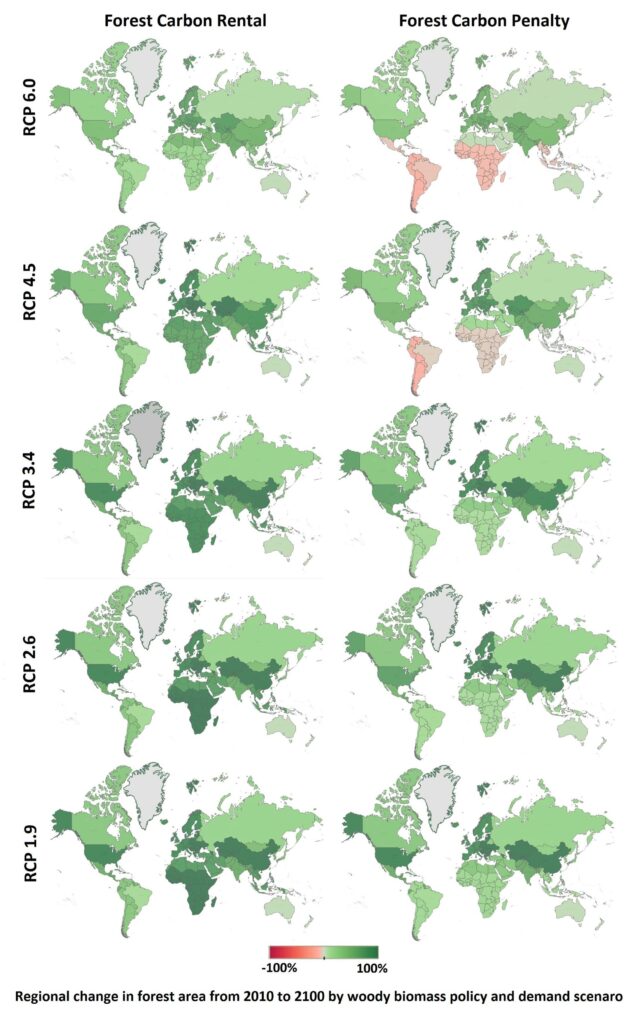Researchers model spatial and temporal consequences of increased woody biomass use on the global forest ecosystem
Incentivizing both sequestration and avoidance of emissions— using a carbon rental or carbon tax and subsidy approach — versus only a carbon tax encourages protection of natural forests by valuing the standing stock, according to a new study led by Georgia Institute of Technology.
In their study, the research team — Alice Favero, associate director of Graduate Studies at Georgia Institute of Technology’s School of Public Policy; Adam Daigneault, University of Maine E.L. Giddings Assistant Professor of Forest, Conservation and Recreation Policy; and Brent Sohngen, professor of environmental economics at Ohio State University — addressed the impacts of woody biomass demand on forest harvests, prices and related timber management issues. Their findings on the consequences of bioenergy policies on forests and carbon emissions are published in the journal “Science Advances.”
Using the global timber model (GTM) to assess how bioenergy demand affects the forestry sector, forestland and carbon sequestration, the researchers compared timber harvesting and management in more than 200 managed and natural forest ecosystems across 16 world regions under different bioenergy demand scenarios, including a no-bioenergy demand scenario, to isolate the role of management on forest carbon stocks.

While policy approaches vary on the regional level, their modeling analysis of the forest carbon rental payment approach indicates that forest area will increase substantially across the globe, with medium price scenarios leading to 500 million to 700 million new hectares of forests. While about 10% of this new forest is intensively managed nonindigenous plantation types, most of the gain in forests occurs in types that are managed less intensively through traditional silvicultural methods.
The study also shows that the carbon rental approach safely maintains most natural forests throughout much of the world, and encourages an expansion in natural forests in tropical regions where carbon density is high.
“We can have our cake and eat it too,” says Daigneault. “Our findings illustrate that a sensible climate policy includes a large biomass program matched with a carbon sequestration program that together promote afforestation, forest management and forest protection.”
The findings can advance the policy discussion by capturing realistic dynamics of how landowners respond to incentives; namely, that economic incentives from biomass and carbon markets can promote more forest management and afforestation, Daigneault says. “Furthermore, our model accounts for past accumulation of carbon embodied in current forest stocks, which is an important component of the global carbon budget.”
For Maine and Georgia, two states at the center of forestry in the United States, the model shows that a biomass policy with carbon sequestration incentives would be a great boon to the forestry sector.
“There are opportunities in Maine to increase investments in the timber industry if biomass energy markets emerge, and this study indicates how we can do it safely for the environment,” says forestry professional Kenny Fergusson of Huber Resources Corp.
A concern of many environmental organizations is expansion of biomass energy in the U.S. and globally that would harm ecosystems by encouraging most forests to become industrial timber plantations. This study shows how that can be avoided, according to the researchers.
“This study highlights how we need to move beyond the biomass carbon neutrality debate,” Favero says. “Policy should not be a focus on either forest carbon or biomass carbon, but rather how to incentivize both. Simply penalizing emissions from bioenergy without an offsetting subsidy for carbon accumulation is an inefficient climate policy because it creates relatively less demand for forest products, depresses timber prices and reduces forest area.”
By taking into account dynamic market and management responses, the study provides an improved understanding of the benefits and risks of increasing global bioenergy demand on forests and forest carbon mitigation potential under alternative policy scenarios, the researchers write.
Contact: Adam Daigneault, adam.daigneault@maine.edu
